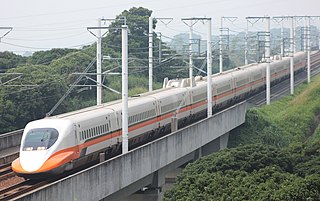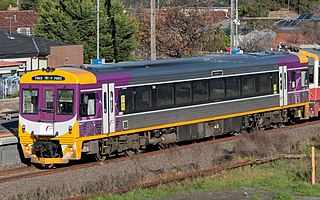
Accessibility is the design of products, devices, services, vehicles, or environments so as to be usable by people with disabilities. The concept of accessible design and practice of accessible development ensures both "direct access" and "indirect access" meaning compatibility with a person's assistive technology.

The THSR 700T is the high-speed electric multiple unit trainset derived from the Japanese Shinkansen family for Taiwan High Speed Rail (THSR), Taiwan's high-speed rail line. The THSR 700T is based primarily on the 700 Series Shinkansen that currently operates on the San'yō Shinkansen line and previously on the Tokaido Shinkansen line in Japan, with the "T" referring to Taiwan. The trains were manufactured in Japan by Kawasaki Heavy Industries, Nippon Sharyo, and Hitachi, Ltd., marking the first time Japanese Shinkansen trains have been exported overseas. 30 trains were delivered to THSR operator Taiwan High Speed Rail Corporation (THSRC), and are in regular service with a top speed of 300 kilometres per hour (186 mph) since the line's opening on January 5, 2007.

A low-floor bus is a bus or trolleybus that has no steps between the ground and the floor of the bus at one or more entrances, and low floor for part or all of the passenger cabin. A bus with a partial low floor may also be referred to as a low-entry bus or seldom a flat-floor bus in some locations.

Paratransit is the term used in North America, also known by other names such as community transport (UK), for transportation services that supplement fixed-route mass transit by providing individualized rides without fixed routes or timetables. Paratransit services may vary considerably on the degree of flexibility they provide their customers. At their simplest they may consist of a taxi or small bus that will run along a more or less defined route and then stop to pick up or discharge passengers on request. At the other end of the spectrum—fully demand responsive transport—the most flexible paratransit systems offer on-demand call-up door-to-door service from any origin to any destination in a service area. In addition to public transit agencies, paratransit services may be operated by community groups or not-for-profit organizations, and for-profit private companies or operators.

The British Rail Class 220 Voyager is a class of diesel-electric high-speed multiple unit passenger trains built in Belgium by Bombardier Transportation in 2000 and 2001. They were introduced in 2001 to replace the 20-year-old InterCity 125 and almost 40-year-old Class 47-hauled Mark 2 fleets operating on the Cross Country Route. They were initially operated by Virgin CrossCountry and since 2007 have been operated by CrossCountry.

LeShuttle is a railway shuttle service between Calais in France and Folkestone in United Kingdom. It conveys road vehicles and passengers by rail through the Channel Tunnel. Freight vehicles are carried in separate shuttle trains hauled by the same locomotives, that also contain a passenger carriage, known as the Club Car.

The British Rail Class 465 Networker is a class of 147 electric multiple units built by Metro-Cammell, British Rail Engineering Limited (BREL) and ABB Rail between 1991 and 1994. Originally operated by Network South East, these units are now run by Southeastern.

A wheelchair-accessible van is a vehicle that has been modified by increasing the interior size of the vehicle and equipping it with a means of wheelchair entry, such as a wheelchair ramp or powered lift.
Accessibility for people with disabilities on the Toronto Transit Commission (TTC) system is incomplete but improving. Most of the Toronto subway system was built before wheelchair access was a requirement under the Ontarians with Disabilities Act (ODA). However, all subway stations built since 1996 are equipped with elevators, and elevators have been installed in 44 stations built before 1996. Over 75 percent of Toronto's subway stations are accessible. The original plan was to make all stations accessible by 2025; however, a few stations might not be accessible until 2026.

Accessible toilets are toilets that have been specially designed to better accommodate people with physical disabilities. Persons with reduced mobility find them useful, as do those with weak legs, as a higher toilet bowl makes it easier for them to stand up. Additional measures that can be taken to add accessibility to a toilet include providing more space, adding grab bars to ease transfer to and from the toilet seat, and providing extra room for a caregiver if necessary. Some countries have requirements concerning the accessibility of public toilets. Toilets in private homes can be modified (retrofitted) to increase accessibility.
The Disabled Persons Railcard is a concessionary fare scheme in the United Kingdom giving eligible passengers with disabilities benefits on the National Rail network including a 1/3 discount on fares.

The Sprinter is a diesel railcar built by A Goninan & Co in Broadmeadow, NSW for V/Line between 1993 and 1995.

A wheelchair lift, also known as a platform lift, or vertical platform lift, is a fully powered device designed to raise a wheelchair and its occupant in order to overcome a step or similar vertical barrier.

The Toronto Rocket (TR) is the fifth and latest series of rolling stock used in the Toronto subway system in Toronto, Ontario, Canada. Owned and operated by the Toronto Transit Commission (TTC), the trains were built by Bombardier Transportation in Thunder Bay, Ontario, to replace the last remaining H-series trains, as well as increase capacity for the Spadina subway extension to Vaughan that opened in 2017. They operate in a six-car configuration on Line 1 Yonge–University and a four-car configuration on Line 4 Sheppard. The sets are stored and maintained at the Wilson and Davisville Yards. The first six-car TR train entered passenger service on Line 1 in July 2011, and four-car TR trainsets entered service on Line 4 in May 2016.

A wheelchair is a mobilized form of chair using 2 or more wheels, a footrest and armrest usually cushioned. It is used when walking is difficult or impossible to do due to illnesses, injury, disabilities, or age related health conditions.

The CAF Mark 4 are railway carriages operated by Iarnród Éireann in Ireland on the InterCity service from Dublin to Cork. These carriages have no connection to the British Rail Mark 4.

High-floor describes the interior flooring of commuter vehicles primarily used in public transport such as trains, light rail cars and other rail vehicles, along with buses and trolleybuses. Interior floor height is generally measured above the street surface or above the top of the rail. High-floor designs usually result from packaging requirements: mechanical items such as axles, motors, crankshafts, and/or transmissions, or luggage storage spaces are traditionally placed under the interior floor of these vehicles. The term is used in contrast with low-floor designs, which offer a decreased floor and entry height above the street surface. Since low-floor designs generally were developed after high-floor vehicles, the older high-floor design is sometimes also known as conventional or the “traditional” design.

The Harrington Hump is a modular and easy-to-install system by which the height of a railway platform can be increased at relatively low cost. The system takes its name from Harrington railway station in Cumbria, England, which is the location of the first production version. From 2011, Harrington Humps have been installed slowly at other railway stations in the UK.

The European Union Persons with Reduced Mobility (PRM) legislation is intended to ensure that Persons with Reduced Mobility (whether disabled, elderly or otherwise) traveling via public transport, whether by air, land or sea, should have equal access to travel as compared to travelers with unrestricted mobility. Travel providers are compelled to provide and install sufficient access facilities to enable Passenger with Reduced Mobility to enjoy similar access to other passengers (where feasible and with certain safety exemptions).

The British Rail Mark 5 is the designation given to locomotive-hauled rail carriages built by Spanish manufacturer CAF for operation with Caledonian Sleeper.



















